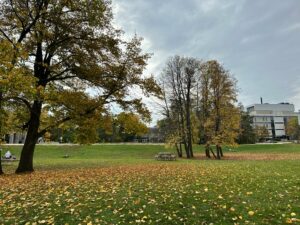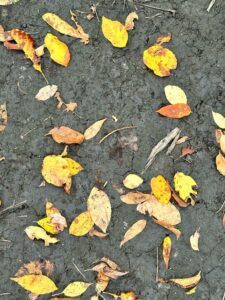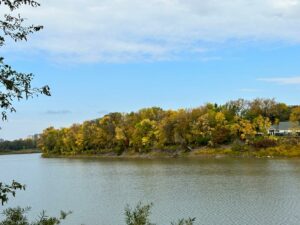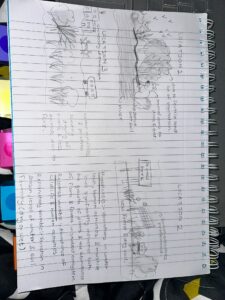I would like to study trees, shrubs, vegetation and fauna in this blog post. The 3 different areas I have chosen are :
Area 1 is located near the river’s bank, where numerous trees flourish amidst dense vegetation. The soil in this area is exceptionally fertile, characterized by its rich, dark colour, creating an ideal habitat for a diverse array of flora and fauna. During the spring and summer seasons, an abundance of trees and small grasses thrive here. Additionally, wildlife is drawn to this location for its access to water, making it a vital resource for both flora and fauna.
Area 2 is a park frequented by people for recreational activities and is situated at a slight distance from the riverbank. The land in this area is predominantly flat and covered in grassland, with only a sparse presence of trees. Furthermore, the soil here is brown and notably drier compared to the other sites.
Area 3 is situated adjacent to the university, featuring naturally occurring land. However, there is no nearby water source to nourish the vegetation. Consequently, I observed that many trees were in a state of decline during the parched summer months and throughout the year. Additionally, this location is subjected to higher levels of pollution due to its proximity to the university.
Hypothesis: Variations in water levels, human activities, and moisture levels significantly influence both the growth of plants and the abundance of flora and fauna in the studied ecosystem.
Prediction: As the seasons change, particularly in Area 1 near the river’s bank, where temperatures can reach extremes leading to the freezing of the river, vegetation may experience stress and damage to their roots and other vital parts. This stress could result in the shedding of leaves and potential adverse effects on plant health, particularly in Area 1. In contrast, in Areas 2 and 3, where human activities are more pronounced due to recreational use and university proximity, wildlife may exhibit avoidance behavior, seeking refuge in denser vegetated areas to minimize interactions with humans. Consequently, Area 1 is expected to maintain a relatively higher presence of birds and animals compared to the other two locations throughout the year.
Response variable: Abundance of wildlife and human activities. It will be categorical.
Explanatory variable: Variation in season, level of water, and soil fertility(dry or wet).
It will be continuous.




You need to focus this study on one clear predictor and response variable. I feel you have too much going on here. Your hypothesis includes both soil moisture and human activity levels but I am not sure how you will tease these out? You would need 2 wet areas with low and high human use and dry areas with low and high human use. In your case, you have an area close the the river bank that is natural and then area 2 which is dry and a park so presumably has higher human use. You also talk about area 2 as a grassland and it is not clear if it is natural or you mean it is a park with grass. In this case you can’t distinguish whether area 2 is different because it is drier than area 1 or if it is because it has higher human use than area 1.
I am also confused because then your prediction starts to talk about animal use of the area and animals are not specifically mentioned in your hypothesis. I see your hypothesis mentions both flora and fauna but you need to choose one or the other.
Your blog post provides a comprehensive overview of the chosen study areas and their characteristics.The prediction and hypothesis are well-stated, but for a clearer and more focused investigation, I would suggest narrowing the focus to either soil moisture levels or levels of human activity. Additionally, focusing on a single response variable, like the abundance of a particular species, would make the research more understandable. The study’s overall accuracy will be improved by carefully planning it and taking potential confounding variables into account. Overall, your study shows great potential, and with some minor adjustments, it can yield valuable insights into the ecosystem under investigation. Good job!